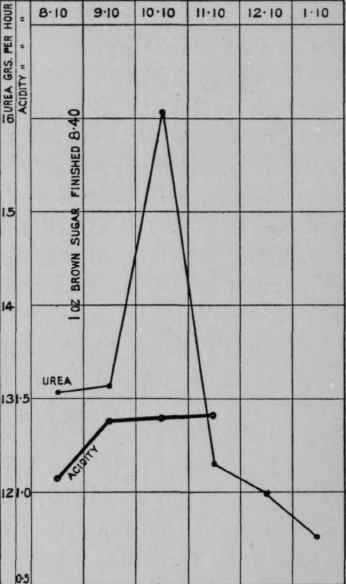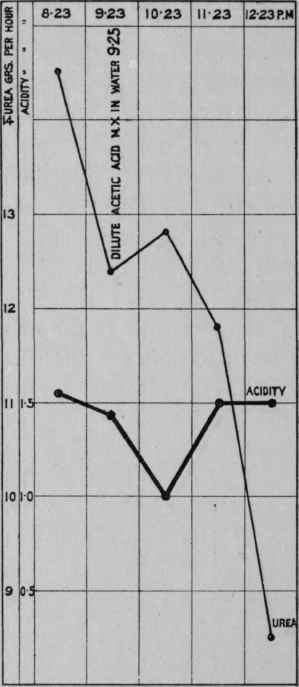Some Points In The Physiology Of Albumen And Urea. Part 4
Description
This section is from the book "Diet And Food Considered In Relation To Strength And Power Of Endurance, Training And Athletics", by Alexander Haig. Also available from Amazon: Diet and Food, Considered in Relation to Strength and Power of Endurance, Training and Athletics.
Some Points In The Physiology Of Albumen And Urea. Part 4
Those who are in doubt should put the matter to the test and judge by the results.
In those, who cannot digest these hardened albumens at all, they may act as irritants and upset digestion of other foods as well, causing, it may be, more or less severe dyspepsia, with loss of weight and strength, so that something like actual starvation may result, even on a diet of which the calculated albumens are sufficient. It is in some cases not only useless to swallow hard or desiccated albumens, but it may be actually dangerous to do so.
On the other hand small quantities of such indigestible substances as a few Brazil nuts, three times a day before meals, will sometimes cure chronic constipation which is otherwise almost incurable, and they probably bring about this result by leaving undigested residues which stimulate the intestines and promote peristalsis; figs, prunes, wholemeal or brown bread may be mentioned as having more or less similar effects.
In all cases it is necessary to hit the happy mean between constipation on the one hand, and chronic dyspepsia with starvation on the other; and those who have altered their diet without knowing much about physiology have not always kept these points sufficiently in mind.
Then in those who have previously suffered from intestinal irritation, such as gout of the intestines, appendicitis, etc., such indigestible substances must 2 be specially avoided, or relapse of their troubles may be produced.
Fig. 4 shows the effect of swallowing 1 oz. of brown sugar, which was finished at 8.40 a.m.

Fig. 4. - Effects of sugar on the excretion of urea and of acid.
Here we see a very marked rise of urea, from 13 grains in the hour ending 9.10, to 16 grains in that ending 10.10, followed by a fall down to 11.5 grains in the hour ending 1.10 p.m.
Now this rise of urea cannot be directly due to the sugar, for it contains no nitrogen, but the result is probably due to the rise of acidity which precedes it.
Below the urea curve is shown the excretion of acid in the urine in grains per hour, and from this we see that there was a marked rise in the excretion of acid in the hour ending 9.10, and that it kept at the same level in the two following hours.
Now readers of "Uric Acid" already know that every rise of acidity is accompanied or followed by a rise of urea. And we gather from works on physiological chemistry that the rise of acidity which sugar produces is due to the effects of lactic and butyric fermentation in the alimentary canal.
This, no doubt, also accounts for the bad name which sugar has had for many years as a producer of gout and rheumatism; though we can now see that sugar merely produced these troubles indirectly by its effects on acidity and the solubility of uric acid, and that, if uric acid supplies are kept low, while the supply of fresh vegetables and fruits is good, sugar can do no harm. In a word, the trouble with sugar has arisen from associating it with animal flesh; while taken with plenty of vegetables and fruits it is harmless. The rise of acidity shown in our figure would do no harm to a frugivore, but in a flesh-eater it might precipitate an arthritis.
And this rise in acidity was probably due to the sugar, as normally the rise in the acidity of the urine does not begin till 10.0 a.m., and when it begins it generally continues to rise slowly all the way to 2.0 or 3.0 p.m. (see "Uric Acid," fig. 3), but this rise, beginning at 9.10 a.m., does not increase in the two following hours.

Fig. 5. - Effects of an acid on the excretion of urea and of acid.
Now fig. 5 shows a similar curve, in which at 9.23 mx. of dilute acetic acid were taken, and this is followed by a break in the downward trend of the urea curve which, however, again falls rapidly to 8.5 grains in the hour ending 12.23.
Below the urea curve is the acidity curve, and this does not at once rise after the acid is taken, but in the hour ending 11.23 there is a decided rise, and this is not due to the normal rise at that hour, because it does not continue to rise in the hour ending 12.23.
I take it, therefore, that the rise at 11.23 was due to the acetic acid, and that the acidity (looking to the rapid fall of urea from 14 to 8.5 grains in about four hours) would have fallen further at 10.23 but for the acid taken, and that this acid affected the blood before its full effect became visible in the urine, and the rise of urea was the effect of the acid on the circulation of the blood. But it may be said, how was it that with a small rise of acid of 1/2 grain in fig. 4, there was a rise of 3 grains in urea, while with a rise of about 1 grain of acid in fig. 5 there was a rise of probably less than 2 grains of urea?
But as already shown in "Uric Acid," pp. 340 and 542, the rise of urea that follows the taking of an acid or a rise of acidity otherwise caused, is not proportional to that rise of acidity, but rather to the condition of the blood and tissues when the acid is taken and the rise of acidity affects them.
Continue to:


